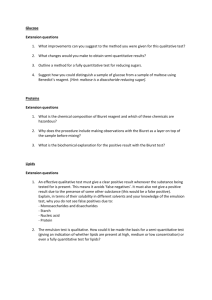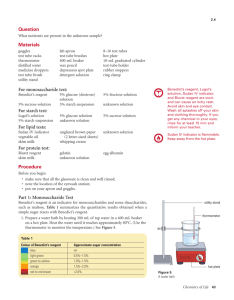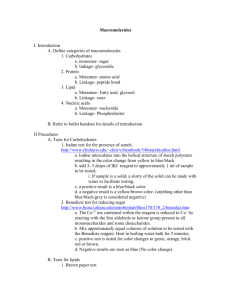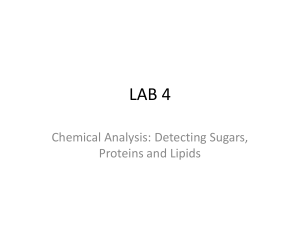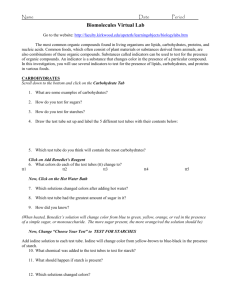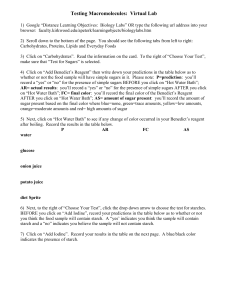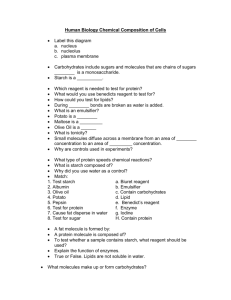File - Principles of Biology 103
advertisement
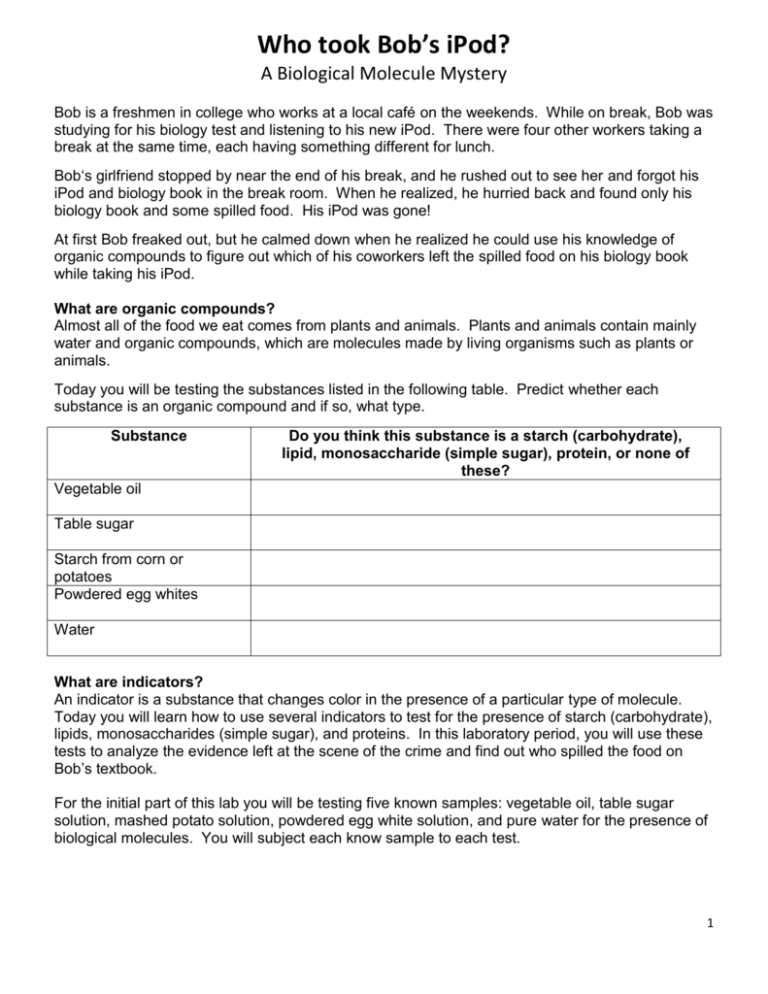
Who took Bob’s iPod? A Biological Molecule Mystery Bob is a freshmen in college who works at a local café on the weekends. While on break, Bob was studying for his biology test and listening to his new iPod. There were four other workers taking a break at the same time, each having something different for lunch. Bob‘s girlfriend stopped by near the end of his break, and he rushed out to see her and forgot his iPod and biology book in the break room. When he realized, he hurried back and found only his biology book and some spilled food. His iPod was gone! At first Bob freaked out, but he calmed down when he realized he could use his knowledge of organic compounds to figure out which of his coworkers left the spilled food on his biology book while taking his iPod. What are organic compounds? Almost all of the food we eat comes from plants and animals. Plants and animals contain mainly water and organic compounds, which are molecules made by living organisms such as plants or animals. Today you will be testing the substances listed in the following table. Predict whether each substance is an organic compound and if so, what type. Substance Do you think this substance is a starch (carbohydrate), lipid, monosaccharide (simple sugar), protein, or none of these? Vegetable oil Table sugar Starch from corn or potatoes Powdered egg whites Water What are indicators? An indicator is a substance that changes color in the presence of a particular type of molecule. Today you will learn how to use several indicators to test for the presence of starch (carbohydrate), lipids, monosaccharides (simple sugar), and proteins. In this laboratory period, you will use these tests to analyze the evidence left at the scene of the crime and find out who spilled the food on Bob’s textbook. For the initial part of this lab you will be testing five known samples: vegetable oil, table sugar solution, mashed potato solution, powdered egg white solution, and pure water for the presence of biological molecules. You will subject each know sample to each test. 1 Testing for lipids: Sudan IV Test Lipids are fat molecules that are insoluble in water (hydrophobic). Like lipids, the chemical Sudan IV is not soluble in water. it is, however, soluble in lipids. Therefore to test for the presence of lipids in a solution you will use a Sudan IV Test. In this test dark red Sudan IV is added to a solution along with ethanol to dissolve any possible lipids. If lipids are present the Sudan IV will stain them reddish-orange, giving a positive test. 1. Add 1ml of each known sample to individual labeled cell well of a cell plate (one sample per cell well) 2. Add 3 drops of a prepared Sudan IV solution to each known sample 3. Mix together known sample and Sudan IV solution by swirling the cell well plate 4. Add 2ml of water to each known sample If fats or oils are present in your known samples they will appear as surface floating red droplets or as a floating red layer colored by the Sudan IV dye 4. Record the outcomes of the reactions occurring in each of your known samples Substance Vegetable oil Table sugar solution Mashed potato solution Powered egg white solution Pure water Sudan IV Test Results Lipid or Not Lipid Testing for Monosaccharides (simple sugar): Benedict’s Test To test for the presence of monosaccharides (simple sugar) you will use the Benedict’s Test. Benedict’s reagent is clear blue (from the presence of cupric copper ions) but when combined and heated to boiling with a substance containing monosaccharides, the cupric ions are reduced to a cuprous form and then oxidized to form copper oxide. Copper oxide is a brownish-orange substance that is insoluble in water. Therefore, a positive reaction in a Benedict’s Test is the change of the clear light blue solution to an opaque orange-brown solution in a a boiling water bath. This color change indicates the presence of monosaccharides in a given solution. 1. Place 2ml of each known sample in a series of glass test tubes (one known sample per test tube) 2. Add 2ml of Benedict's reagent to each of your tube; gently mix the test tube contents and record the initial color 3. Heat the test tubes in a boiling water bath for 3 minutes 4. Take out your test tubes and place them in a metal rack 5. Record the color changes in each test tube 2 Substance Color Prior to Heat Color After Heat Monosaccharide or No Monosaccharide Vegetable oil Table sugar solution Mashed potato solution Powdered egg white solution Pure water Testing for Starches (carbohydrates): Lugol’s Reagent To test for the presence of starch, the Lugol’s reagent is used. This is a simple test in which iodine is added to a given solution. If a polysaccharide such as starch is present then the iodine ion will lodge itself in the polysaccharide chain and give it a black-blue color. If iodine added to a solution turns black-blue than starch is present. If the solution remains the color of iodine, reddish-orange, there is no starch present. 1. Add 1ml of each known sample to individual labeled cell well of a cell plate (one sample per cell well) 2. Add several 10 drops of Lugol's reagent (I2KI solution) to each tube, mix and immediately record your color changes in the corresponding cell wells Substance Vegetable oil Table sugar solution Mashed potato solution Powered egg white solution Pure water Lugol’s Reagent Results Starch or No Starch Testing for Proteins: Biuret Test The last macromolecule you will explore in this lab is protein. In this lab you will test for the presence of protein using the Biuret Test. Like the Benedict’s Reagent, Biuret Reagent contains copper ions. These copper ions reflect off closely clustered amide groups of proteins casting a violet color to a solution with proteins. This violet color is a positive reaction in a Biuret Test. 1. Add 1ml of each known sample to individual labeled cell well of a cell plate (one sample per cell well) 2. Add about 1 ml of water to each container. Stir the contents of each container to mix the substance with the water. 3. Add 10 drops of biuret reagent to each container. Stir the contents of each container. CAUTION: Biuret reagent contains sodium hydroxide, a strong base. Be very careful not to splash or spill any. If you splash any reagent on yourself, wash it off immediately with water. Call your instructor for assistance. 3 Substance Vegetable oil Table sugar solution Mashed potato solution Powered egg white solution Pure water Biuret Test Results Protein or No Protein Solving the Mystery Today you and your classmates will solve the mystery of who stole Bob's iPod by figuring out which coworker's lunch had the same organic compounds as the evidence Bob found at the crime scene. Begin by predicting which types of compounds you expect to find in each type of food. Food Do you expect this food to contain Monosaccharide Starch Protein Lipid Pretzel Butter Jelly Fat-free yogurt Beans In addition to these known samples, your group will be assigned a evidence sample to test. Record your test results in the data table below. Testing for lipids: Sudan IV Test 1. Add 1ml of each known sample to individual labeled cell well of a cell plate (one sample per cell well) 2. Add 3 drops of a prepared Sudan IV solution to each known sample 3. Mix together known sample and Sudan IV solution by swirling the cell well plate 4. Add 2ml of water to each known sample If fats or oils are present in your known samples they will appear as surface floating red droplets or as a floating red layer colored by the Sudan IV dye 4. Record the outcomes of the reactions occurring in each of your known samples Substance Pretzel Butter Jelly Fat-free yogurt Beans Sudan IV Test Results Lipid or Not Lipid 4 Testing for Monosaccharides (simple sugar): Benedict’s Test for Reducing Sugars 1. Place 2ml of each known sample in a series of glass test tubes (one known sample per test tube) 2. Add 2ml of Benedict's reagent to each of your tube; gently mix the test tube contents and record the initial color 3. Heat the test tubes in a boiling water bath for 3 minutes 4. Take out your test tubes and place them in a metal rack 5. Record the color changes in each test tube Substance Color Prior to Heat Color After Heat Monosaccharide or No Monosaccharide Pretzel Butter Jelly Fat-free yogurt Beans Testing for Starches (carbohydrates): Lugol’s Reagent 1. Add 1ml of each known sample to individual labeled cell well of a cell plate (one sample per cell well) 2. Add 10 drops of Lugol's reagent (I2KI solution) to each tube, mix and immediately record your color changes in the corresponding cell wells Substance Pretzel Butter Jelly Fat-free yogurt Beans Lugol’s Reagent Results Starch or No Starch Testing for Proteins: Biuret Test 1. Add 1ml of each known sample to individual labeled cell well of a cell plate (one sample per cell well) 2. Add about 1 ml of water to each container. Stir the contents of each container to mix the substance with the water. 3. Add 10 drops of biuret reagent to each container. Stir the contents of each container. CAUTION: Biuret reagent contains sodium hydroxide, a strong base. Be very careful not to splash or spill any. If you splash any reagent on yourself, wash it off immediately with water. Call your instructor for assistance. 5 Substance Pretzels Butter Jelly Fat-free yogurt Beans Biuret Test Results Protein or No Protein Who took Bob’s iPod? The table shows what each worker in the break room was eating while Bob was studying. Use the information from the table on the bottom of page 5 to complete this table to show which types of organic compounds would be in each lunch and which types of organic compounds were found in the evidence. Worker in break room Mark Ashley Bruce Lisa Thief Lunch he or she was eating Glucose Starch Protein Lipid Bean burrito with cheese Fat-Free Yogurt Toast with butter and jelly Pretzel Collected Evidence Complete the following table to summarize the evidence and your interpretation of the evidence. Worker in break room Mark Did he/she take Bob’s ipod? How do you know? Describe the evidence that supports your conclusion. Ashley Bruce Lisa 6
